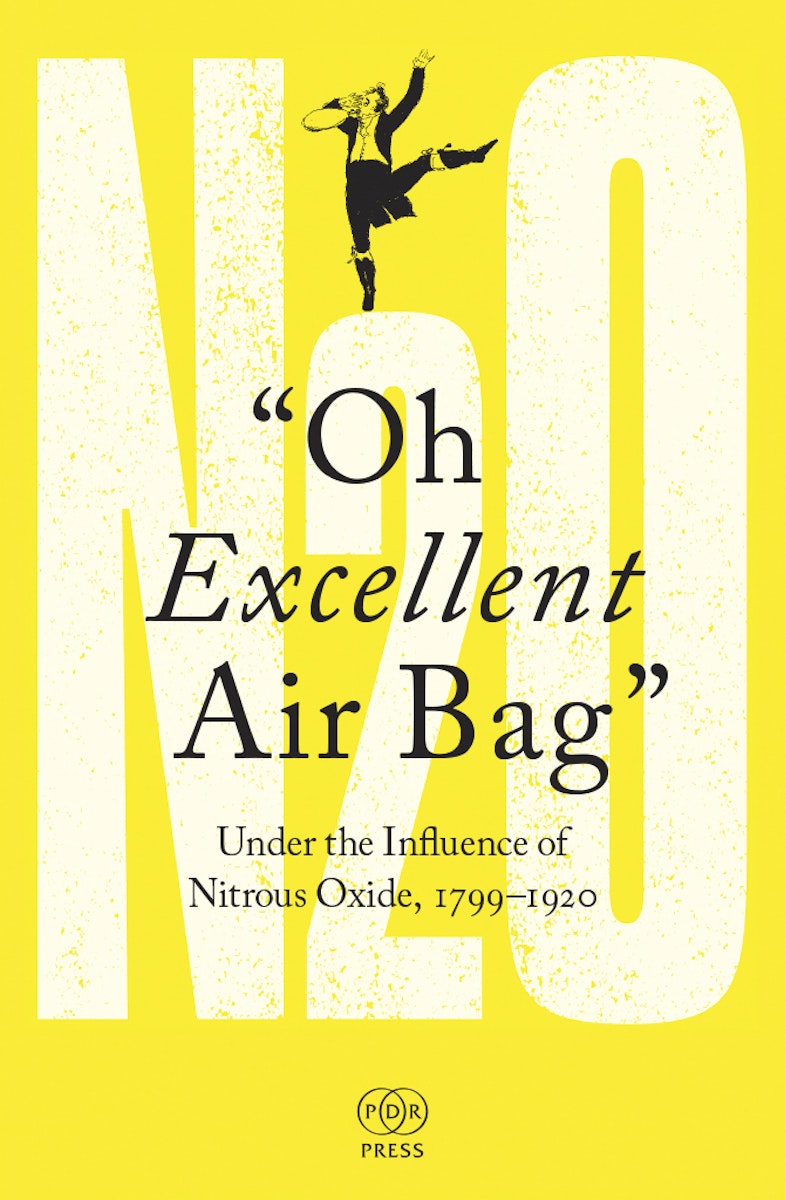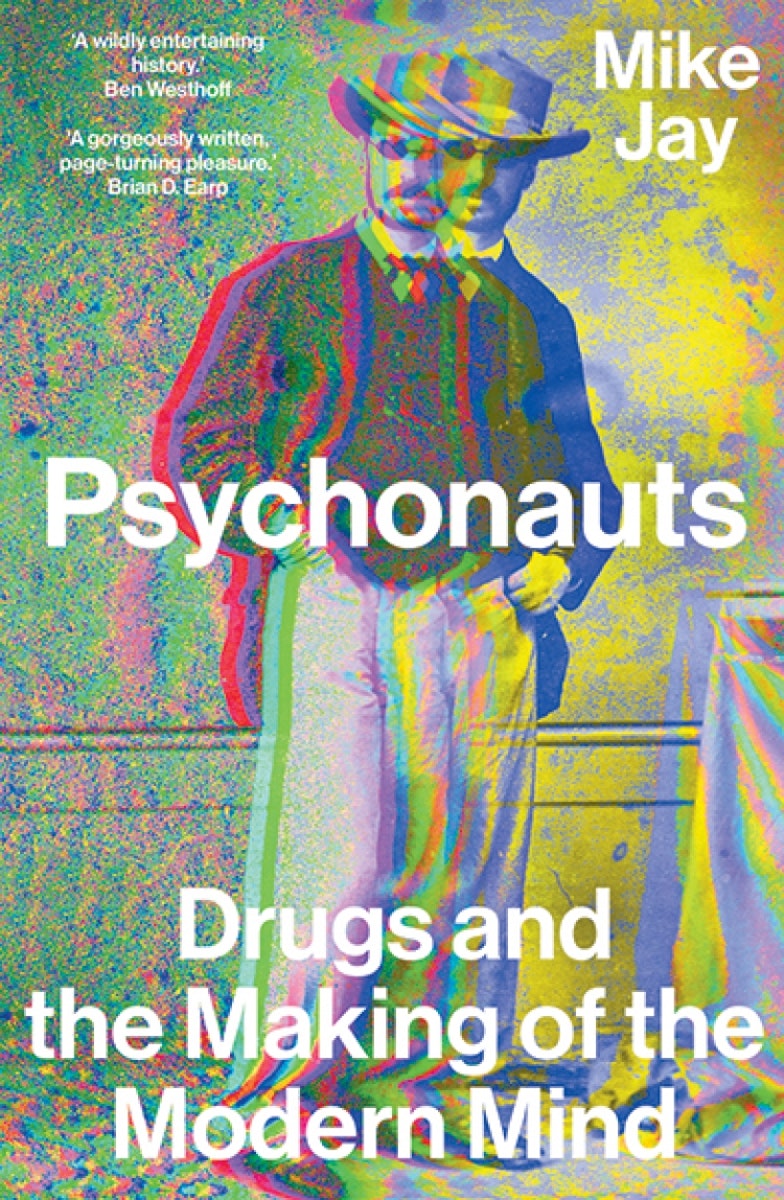
The Ether Dreams of Fin-de-Siècle Paris
Those who sipped or sniffed ether and chloroform in the 19th century experienced a range of effects from these repurposed anaesthetics, including preternatural mental clarity, psychological hauntings, and slippages of space and time. Mike Jay explores how the powerful solvents shaped the writings of Guy de Maupassant and Jean Lorrain — psychonauts who opened the door to an invisible dimension of mind and suffered Promethean consequences.
May 3, 2023
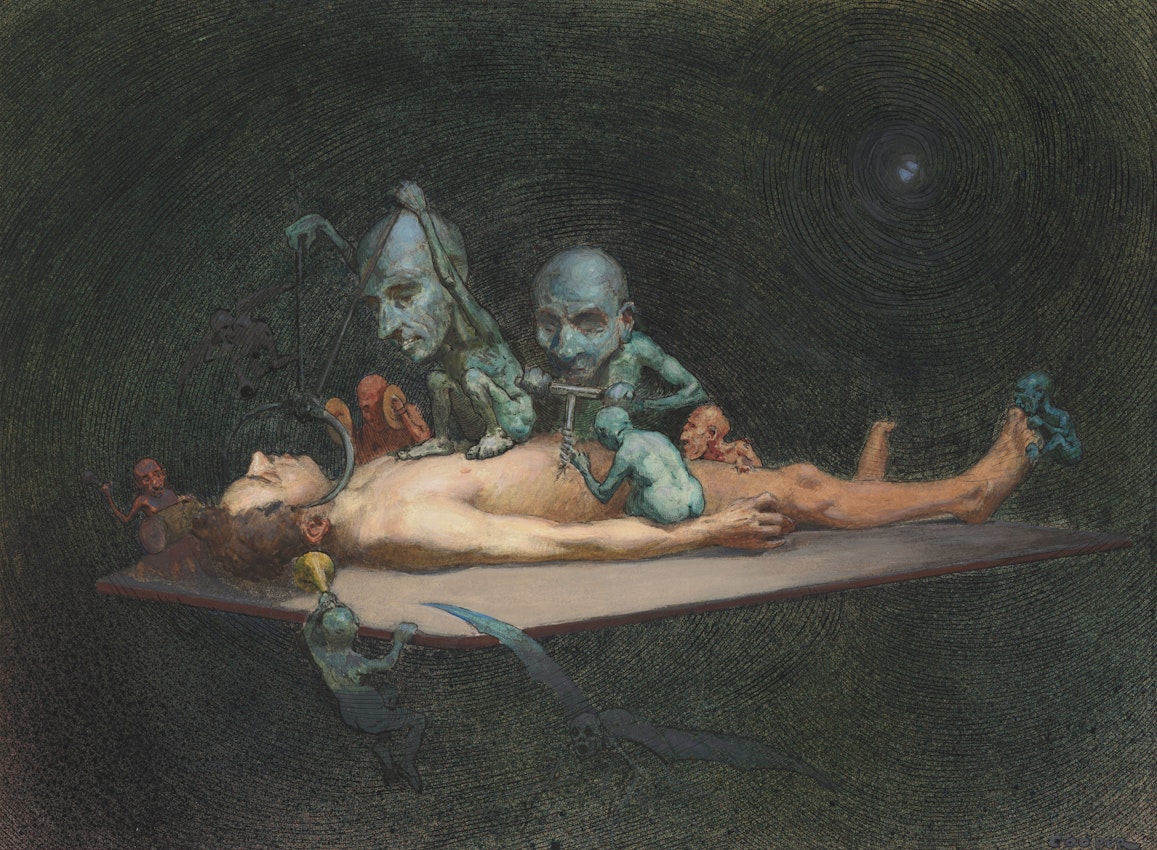 Scroll through the whole page to download all images before printing.
Scroll through the whole page to download all images before printing.Painting by Richard Tennant Cooper representing the effects of chloroform, ca. 1912 — Source.
First routinely employed as surgical anaesthetics in the 1840s, diethyl ether and chloroform were no longer confined to operating theatres by the century’s close. Now widely available in pharmacies, these powerful solvents were inhaled as soothing vapours for chest and lung conditions, as an analgesic for aches and pains, and as fast-acting tranquillisers for panic attacks and other nervous conditions. Doctors and journalists commented disapprovingly on chloroform’s “luxurious” use in tea rooms, and on the occasional public sightings of groups of young women giggling and swooning under its influence. At the same time it developed a sinister reputation, thanks to a handful of sensational criminal cases such as that of Henry Howard Holmes, who used it in the murders of an unknown number of people in Chicago during the World’s Fair of 1893. By the late 1890s it was conjoined in yellow journalism and the popular imagination with addiction, suicide, rape, and murder, and with the enduring misconception that a chloroform-soaked rag held over a victim’s face produces an instant loss of consciousness (in reality, this requires continued deep breathing).
The strands of medicine, consciousness expansion, intoxication, addiction, and crime were tightly entangled in fin-de-siècle Paris, where ether and chloroform circulated among bohemian demi-mondaines alongside morphine, opium, cocaine, hashish, and wormwood-infused absinthe. These solvents were often carried in small glass vials and medicine bottles by the asthmatic, tubercular, and neurasthenic, added to patent tonics and syrups, and, on occasion, to cocktails: an ether-soaked strawberry floating in champagne produced a heady rush, the fruit preventing the volatile liquid from evaporating too quickly. Literary references to ether abounded, either as a signifier of decadence or as a literary prop to shift a realistic narrative into the landscape of dreams and symbols, where its dissociative qualities became a portal to strange mental states, psychological hauntings, uncanny doublings, and slippages of space and time.
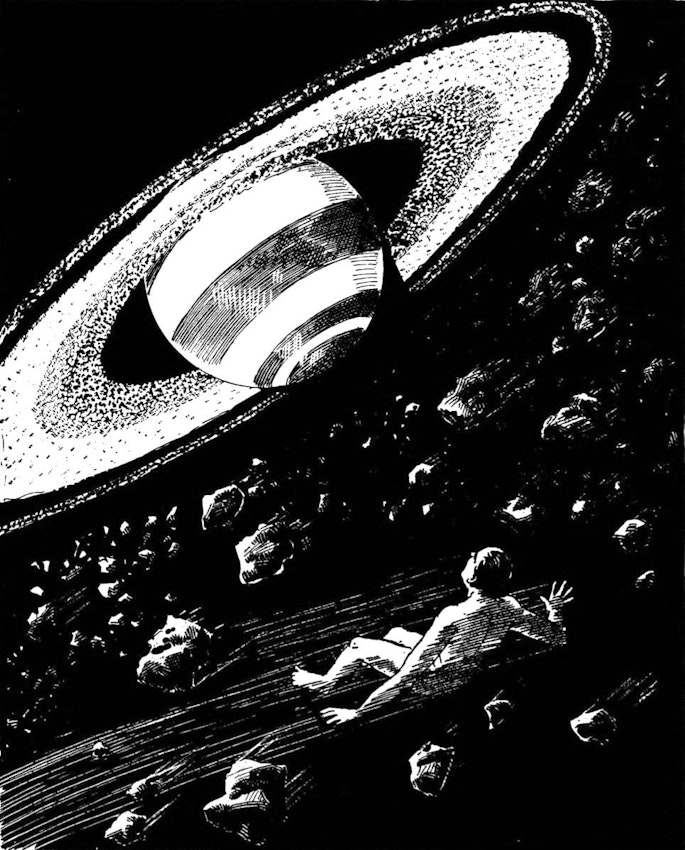 Scroll through the whole page to download all images before printing.
Scroll through the whole page to download all images before printing.Illustration for H. G. Wells’ “Under the Knife”, a story in which chloroform sends a surgical patient on a disembodied cosmic journey — Source
Ether was the subject of Guy de Maupassant’s 1882 short story “Dreams”, in which a group of jaded and neurasthenic diners lament the ennui that consumes their days and the insomnia and bad dreams that ruin their nights. The doctor among them assures them that “real dreaming”, which is “the sweetest experience in the world”, is in the gift of modern medicine. His fellow diners assume he is referring to opium or hashish, which they have already tried; one replies wearily: “I have read Baudelaire, and I even tasted the famous drug, which made me very sick.” But the doctor is speaking of ether, which he first tried to soothe his neuralgia, “and which I have since then, perhaps, slightly abused”. Lying down with an ether bottle and inhaling slowly, he recalls, his body:
became light, as light as if the flesh and the bones had been melted and only the skin was left, the skin necessary to enable me to realize the sweetness of living, of bathing in this sensation of well-being. Then I perceived that I was no longer suffering. The pain had gone, melted away, evaporated. And I heard voices, four voices, two dialogues, without understanding what was said.
Unlike hashish dreams or the “somewhat sickly” visions of opium, the state that followed was one of heightened mental clarity:
I reasoned with the utmost clearness and depth, with extraordinary energy and intellectual pleasure, with a singular intoxication arising from this separation of my mental faculties . . . It seemed to me that I had tasted the Tree of Knowledge, that all the mysteries were unveiled, so much did I find myself under the sway of a new, strange and irrefutable logic. And arguments, reasonings, proofs rose up in a heap before my brain only to be immediately displaced by some stronger proof, reasoning, argument. My head had, in fact, become a battleground of ideas. I was a superior being, armed with invincible intelligence, and I experienced a huge delight at the manifestation of my power.1
The doctor continued inhaling from his bottle for an eternity, carried away in his cerebral reveries, until he looked down and saw that it was empty. Maupassant’s own ether use combined the medical, the sensual, and the philosophical in similar ways. He first tried it as a remedy for his catalogue of persistent medical and neurological conditions, which included migraines, rheumatism, partial blindness, internal bleeding, and fevers; his physicians offered conflicting opinions on their cause, most of which have been retrospectively connected to his eventual deterioration and death from syphilis. The regular use of ether affected him strangely: he described to friends seeing little red men sitting in armchairs, feeling his soul separating from his body and, more than once, walking into his house and seeing himself sitting on his sofa.2
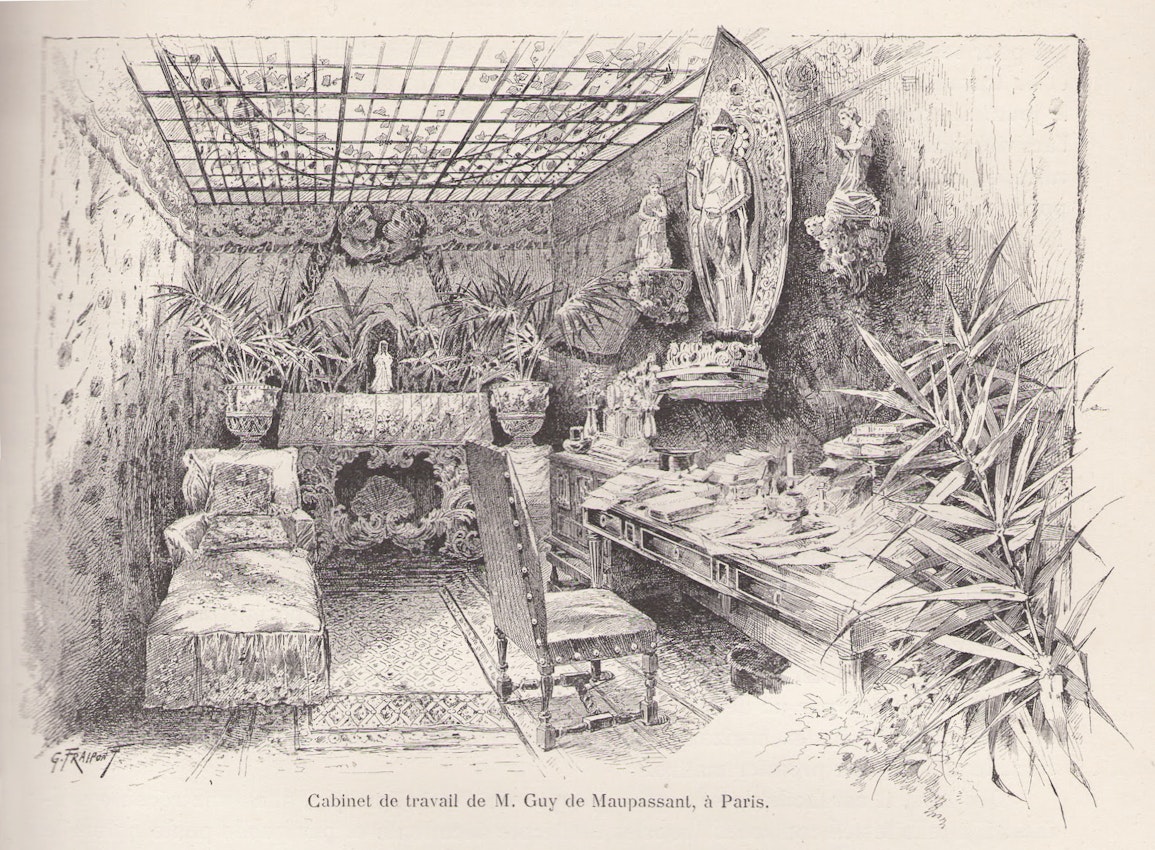 Scroll through the whole page to download all images before printing.
Scroll through the whole page to download all images before printing.The study of Guy de Maupassant as depicted by Gustave Fraipont, ca. 1888 — Source
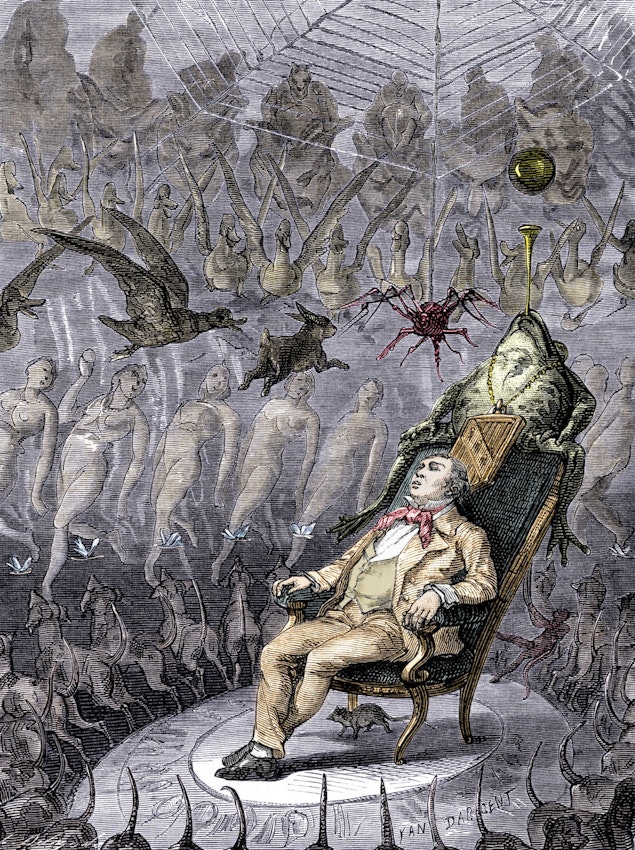 Scroll through the whole page to download all images before printing.
Scroll through the whole page to download all images before printing.Yan' Dargent illustration for Louis Figuier's Les Merveilles de la Science depicting the hallucinatory dreams produced by ether, 1868 — Source
Through the 1890s, as his condition worsened, Maupassant’s hallucinations and psychotic episodes grew more intense, whether from degenerative brain disease or the overuse of ether and other drugs. Ether’s imprint is discernible in the auditory hallucinations he describes, which commence as a ringing in the ears, mount towards a crescendo, and resolve during the ensuing reverie into voices, their words often inaudible or nonsensical but the character and tone of the speaker sharply defined. Disembodied voices were often described in both the medical and the spiritual literature, and were experienced and interpreted in various ways. The British doctor Ernest Dunbar described hearing them on chloroform in a report to the Society for Psychical Research:
It seemed to me that deep down somewhere in my consciousness voices were wrangling and quarrelling . . . This sort of conversation would commence: “So you see we’ve got you again”. Then I would think, “Oh! won’t you leave me alone? I want to rest”, and the answer would come, “We’ll have the last word”, and with that would ensue a muttering and a grumbling, which occasionally rose to a whining complaint from these voices. I have never inhaled chloroform without hearing these voices.3
Where psychic researchers heard telepathic communications, the spirits of the deceased, or the voices of angels, Maupassant tended to interpret them as doublings or splittings of his own mind. In his final years, however, he was unable to dismiss the possibility that they were intimations of something beyond the self: not necessarily spirits or demons as traditionally conceived, but evidence for a disembodied presence that was stalking the modern world. His most sustained fictional exploration of this possibility was his 1887 short story “The Horla”, which abandons the elegant naturalism of his earlier work for a fractured, ambivalent, and perverse narrative in which the rug is constantly pulled from under the narrator’s feet. In a series of ever more harrowing diary entries, the protagonist documents a double consciousness or self-haunting, in which objects in his locked room are interfered with. “I must be the plaything of my enervated imagination”, he decides; or perhaps he has become an amnesiac or a sleepwalker; “or I have been brought under the power of one of those influences — hypnotic suggestion, for example — which are known to exist, but have hitherto been inexplicable”.4 But if he is mad, how can he be so clear-headed and rational?
Some unknown disturbance must have been excited in my brain, one of those disturbances which physiologists of the present day try to note and fix precisely, and that disturbance must have caused a profound gulf in my mind and in the order and logic of my ideas.5
As under ether, arguments and proofs construct themselves with ever greater ingenuity, only to be replaced by others. The anomalies persist and intensify, the gulf widens; before long he is speculating that “Somebody possesses my soul and governs it!”6 The idea takes hold that the scientific investigators have unleashed an entity that feeds on the conscious mind, and over which they have no control:
Mesmer divined him, and ten years ago physicians accurately discovered the nature of his power, even before He exercised it himself. They played with that weapon of their new Lord, the sway of a mysterious will over the human soul, which had become enslaved. They call it mesmerism, hypnotism, suggestion . . . A new being! Why not? It was assuredly bound to come! Why should we be the last?7
-edit.jpeg?fit=max&w=1200&h=850) Scroll through the whole page to download all images before printing.
Scroll through the whole page to download all images before printing.Cover illustration by Vincent Lorant-Heilbronn for Jean Lorrain’s Le Vice Errant, 1902 — Source
The literary figure most closely associated with ether in fin-de-siècle France was the novelist, poet, journalist, and short-story writer Jean Lorrain (1855–1906), whose collection of dark and sardonic tales was published in 1895 under the title Nightmares of an Ether-Drinker. Lorrain was an extreme figure even in decadent Paris: a powdered and bejewelled dandy, scandalous gossip-monger, bohemian, dabbling Satanist, denizen of the city’s criminalised and violent gay underworld, and at the same time its most highly paid writer. “What is a vice?” he shrugged. “Merely a taste you don’t share.”8 His brazen self-advertisement as the Thomas De Quincey of ether was entirely in character, although the stories in the volume tend to mention the drug only obliquely and he never describes his experiences with it as directly as Maupassant did in “Dreams”. Its presence is diffuse, tearing at the veil of reality and punctuating it with surreal juxtapositions and flashes of preternatural clarity. It sets the scene and the mood for stories such as “An Uncanny Crime”, which its narrator begins:
It was two years ago, when my nervous troubles were at their worst. I had recovered from the ether, but not from the morbid phenomena to which it had given birth: hearing things, seeing things, nocturnal panic-attacks and nightmares. Sulphonal and bromide had begun to alleviate the worst symptoms, but my distress continued in spite of medication. These phenomena were at their worst in the apartment on the other side of the river, in the Rue St Guillaume, which I had shared with them for so long. Their presence seemed to have impregnated the walls and fittings, by means of some pernicious sympathetic magic . . . There were bizarre shadows huddling in the corners, suggestive folds in the curtains at the windows, while the door curtains would suddenly be animated by some frightful and nameless semblance of life.9
Lorrain first used ether medicinally, as symptomatic relief for his chronic tuberculosis — similar to his rival Maupassant, who once challenged him to a duel for plagiarism. His illness, and his self-medication with ether, were both woven into his highly cultivated public persona. A close friend of Joris-Karl Huysmans, whose À Rebours (1884) established itself as the decadents’ bible, Lorrain’s writing career straddled the worlds of high aestheticism, well-paid journalism, commercial pulp sensation, and unprintable perversion. Like Huysmans’ masterpiece, many of his stories are not so much narratives as vignettes, mood pieces, or studies of mental states, unfolding in interior monologues that anticipate the modernists’ stream of consciousness. À Rebours includes a lengthy digression on scent, and the transports and associations that can be summoned by it; ether in the writing of Maupassant and particularly Lorrain can be seen as an outgrowth of this obsession amplified to madness. In the salons and cafés, it was often said that you could smell Lorrain’s presence in the room before you saw him. In his fiction, ether’s odour and its dream logic pervade throughout, bringing with them a confusion of associations: the hospital waiting room, the boudoir, the agony of the lungs, the gentle dissociation from reality, the sudden awakening from a nightmare — and, ultimately, the pain of the gastric ulcers that his habit inflicted on him with growing severity.
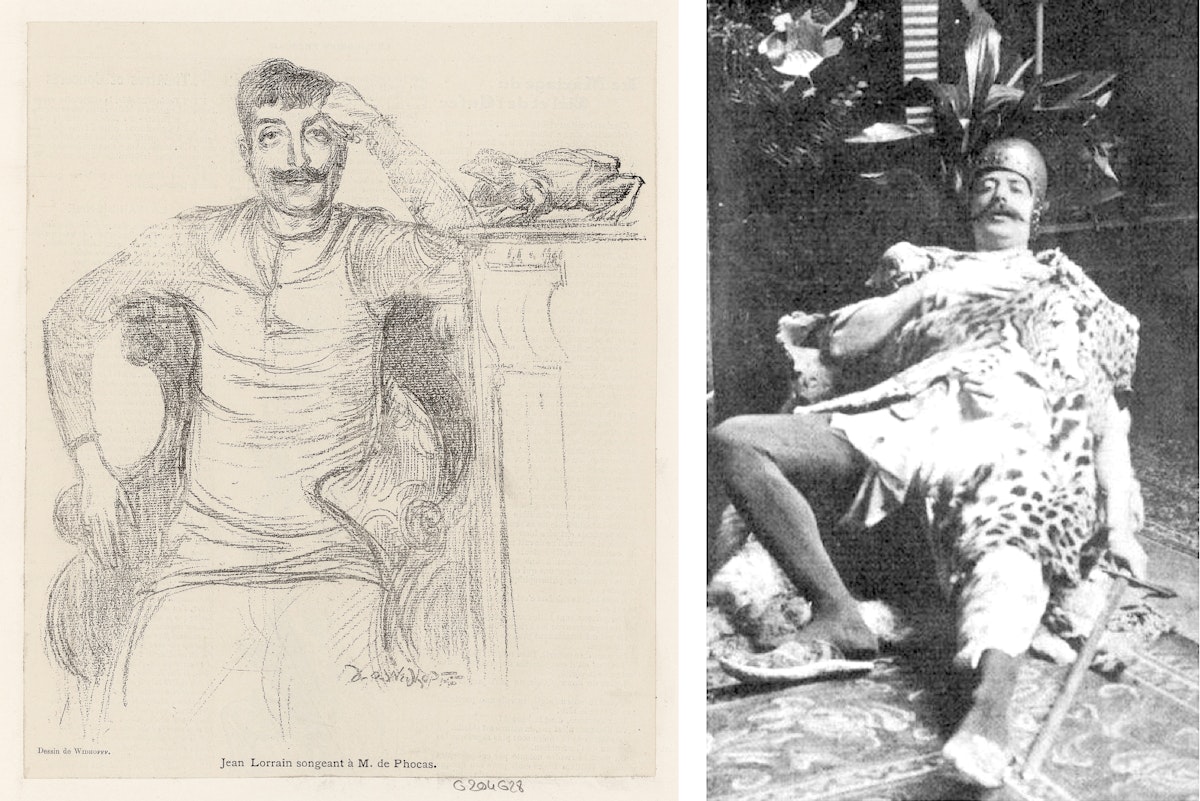 Scroll through the whole page to download all images before printing.
Scroll through the whole page to download all images before printing.Although his ether tales are profoundly haunted, Lorrain was no believer in ghosts or spirits; as he might have said, quoting Samuel Taylor Coleridge, “I have seen far too many myself.”10 Like Huysmans, he investigated Satanism: the pair were habitués of the Chat Noir café, Montmartre’s bohemian hub where the disciples of Jules Michelet discussed witchcraft and sought out secret rites in basements and catacombs, and rumours of secret covens and occult rituals swirl in the background of his tales. In the end, however, neither science nor the supernatural, nor indeed ether, offered sufficient explanation. “Oh, don’t blame it on the ether!” replies the protagonist in the short story “The Possessed” to a friend trying to make sense of his terrifying obsessions:
Nevertheless, I do have to go away. I’d be sure to fall ill again as soon as November arrives, when Paris becomes fantastically haunted. You see, the strangeness of my case is that I no longer fear the invisible, I’m terrified by reality.11
Lorrain’s perverse and shocking novel Monsieur de Phocas (1901) marked the scandalous high-water mark of his career, and the ne plus ultra of French decadent literature. Bankrupted by lawsuits for plagiarism and obscenity, he fell from fashion in the new century and in 1906 suffered an ignominious death of peritonitis after perforating his colon with an enema while attempting to relieve his ether-induced intestinal ulcers. The drug had, like De Quincey’s opium, become his talisman, his trademark, and his curse. It opened the door to an invisible dimension of mind that hypnotism and the mind-doctors were no more capable of explaining than mediums or exorcists. As another of his overwrought protagonists exclaims in the 1891 vignette “Magic Lantern”: “Never has the Fantastic flourished, so sinister and so terrifying, as in modern life!”
Mike Jay has written extensively on scientific and medical history and contributes regularly to the London Review of Books and the Wall Street Journal. His latest book is Psychonauts: Drugs and the Making of the Modern Mind, and his previous books on the history of drugs include Mescaline, High Society, and The Atmosphere of Heaven.
This essay has been excerpted and adapted from Mike Jay, Psychonauts: Drugs and the Making of the Modern Mind (Yale University Press, 2023). Copyright © 2023 Mike Jay.





